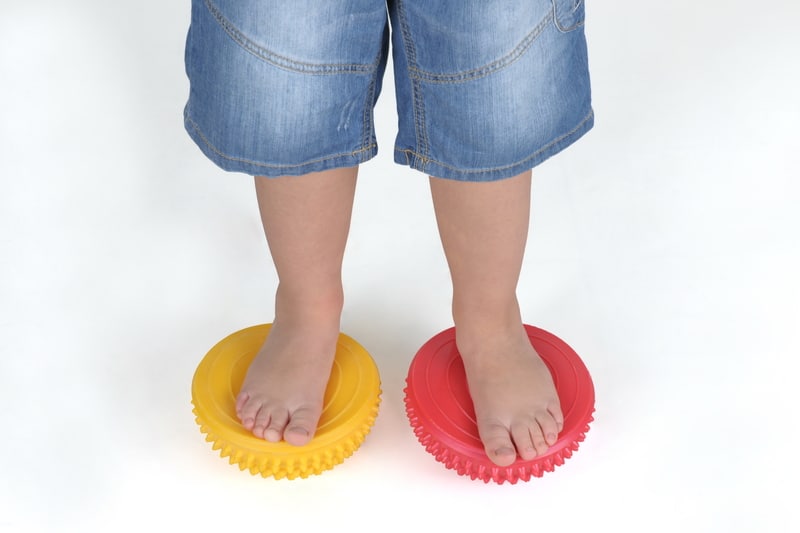Flat feet are one of the more common issues that millions of people deal with every day. It is a condition in which the arches of the feet have not properly developed, and the entire sole will touch the ground.
For parents who see their babies or toddlers with flat feet, do not panic. It takes some time for the arches to develop in their feet. Your physician will let you know if there is some issue with the development of the arches in your child’s feet. It’s also true that many adults will have their arches fall due to wear and tear, but that is a somewhat different condition compared to children who develop flat feet.
The good news for parents is that flat feet are not only common, but they are often painless. If that is the case, then you do not have to worry. However, sometimes flat feet can cause the body to misalign when standing, walking, jogging, or running. In this case, a child may develop issues with their knees and ankles as a result.
Signs of Flat Feet In Toddlers
If your child exhibits the following symptoms, then they may need treatment for their flat feet.
- Pain in the feet, particularly in the arch or heel area
- Pain that increases with motion
- Heel cords that are tight
- Swelling of the ankles
Repeatedly spraining the ankles may be another sign that indicates treatment may be needed. Your doctor should be the first source of information about what to do next.
It helps if you can identify a specific time or incident in which your child started experiencing the pain and discomfort. You may find that the source is something simple and can be addressed immediately, such as poorly fitted shoes. A good way to avoid this condition is to ensure that the shoes fit properly and have the right arch support.
However, in many cases, there is no specific issue that causes the pain and discomforts your child is experiencing. Over time, the growth of their body combined with increased activity has probably caused such issues to gradually appear.
Getting Your Child Tested for Flat Feet

When your child has demonstrated one or more symptoms with their flat feet, they should be tested by a specialist known as a podiatrist. Your doctor will recommend this course of action if necessary. A podiatrist will generally conduct simple tests first to determine if the child’s motion is noticed when walking. Plus, the shoes that they wear every day will be examined to see if any patterns have developed.
The podiatrist will get a full history of the issues, ask the child to describe what is happening with their feet, and if the pain is caused by a particular activity. If the pain is significant, then the following may occur.
- CT Scan: Detailed images of the interior of the feet
- EOS Imaging: Creates a three-dimensional model of the feet
- Magnetic Resonance Imaging (MRI): Shows images of the soft tissues in the feet
- X–ray: To see if the bones of the feet are being affected
X-rays are often the last resort because of the radiation. But if there is a bone issue, the x-ray will show it. The combination of patient history, observation of movement, wear patterns in the shoes, and imaging of the feet itself will provide enough information for the podiatrist to prescribe a treatment.
Treatment Options
Again, if your child is not suffering from any pain, discomfort, or issues that are causing injuries to occur, then you do not need to do anything else. Only when something is wrong, do you need to have the treatment applied.
Lose Weight: If your child is overweight, then the additional pressure may be causing the pain.
Pain Relief Medication: If the pain is temporary, then over the counter or prescription medications may be the answer.
Stretching: If the issue centers on the Achilles tendon, then some stretching exercises may work. This helps to relieve the tightness and reduce the amount of pain.
Support Shoes: In other words, avoid footwear that provides no support such as flip-flops and sandals. Instead, have your child wear shoes that provide arch support, and that may resolve the issue.
Support for Arches: Simple arch supports, which are often inserts for each shoe, may help relieve the pain and discomfort of flat feet. They are relatively inexpensive and can be purchased over the counter, or if your child has a particular issue, the insert can be custom-made.
If the issues with the feet develop because of overuse, such as from excessing running or movement, then the prescription may range from simple rest to physical therapy for pain relief. Your podiatrist will have several exercises that may be quite helpful in this regard.
Keep in mind that surgical solutions are rare and most often not needed. The only exceptions would be a broken bone, torn tendon, or other conditions that warrant surgery.
Another good news for parents that have children with flat feet is that follow-up care is normally not necessary once the condition has been identified. In other words, once the issues causing the pain has been treated, you do not need to have your child undergo yet another examination.
There are exceptions, but mostly regarding if the child has suffered some type of injury. This may change or alter the treatment needed to stop any additional pain. But for the most part, your child should be able to move about with little to no pain or discomfort once the recommended treatment has been applied.
Changing situations such as gaining weight or participating in activities that require additional running or movement may require additional arch support and even new footwear to compensate. Before your child tries out for a sport or activity that considerably increases their activity level, you may want to have them wear more rigid footwear to provide greater support.
Can kids outgrow flat feet?
It has been learned that most kids under the age of five have flat feet. Around 95 percent of them will eventually develop a normal arch and will not have any problems. For those with flat feet, running barefoot can help strengthen the muscles in their ankles and arches. It can also help minimize pain and improve circulation in their feet.
Can hereditary flat feet be corrected?
Having flat feet can be treated through the use of various means, such as wearing shoes that provide adequate support. It can also be treated with the use of orthotics. Flat feet is not a condition that suddenly disappears. There are ways to manage it and prevent it from getting worse.
Can flat feet affect growth?
The soft tissue around their bones will eventually harden and turn into bone. But if they aren’t correctly walking, their bones can get damaged. Individuals with flat feet are not suitable to march and can sustain spinal damage.
Does my child need orthotics?
Most kids do not require orthotic devices. However, there are some exceptions. For some kids, they do require them to support their arch. skin concerns include warts, corns, and calluses. nail conditions include ingrown toenails and odd-shaped nails.
Are orthotics really necessary?
Not everyone needs orthotics. They are often needed for people suffering from conditions such as back pain or joint disorders. Wearing orthotics can cause stress to the joints and muscles in your body, which can then lead to soreness and weak ankles and feet. It’s also difficult to get relief from the incorrect designs of the orthotics.
Why do my orthotics hurt my feet?
Not every issue is caused by a specific product or device. However, if it is a minor issue that can be treated with minimal effort, then a cushioned insert might be just what you need. Your orthotics were not designed or properly fitted. This issue can lead to foot pain and orthosis.
What is a doctor for feet?
A podiatrist is a medical professional who helps people with foot and lower leg problems. They can diagnose and treat various conditions related to the feet. These aids can be used to improve a child’s balance, reduce pain, and improve their shoe size. They can also be used to improve their posture and prevent frequent tripping.
What does a podiatry doctor do?
They diagnose and treat various conditions related to the feet and lower limbs. Most of the time, these conditions are caused by other factors such as arthritis and diabetes. A podiatrist is a healthcare professional who specializes in treating various conditions related to the foot and ankle. They can help improve the function and healing of your foot and lower leg.
Is podiatrist a doctor?
A podiatrist is a physician who specializes in the treatment of foot and ankle conditions. They are also qualified to diagnose and cure conditions that affect the entire leg. If you have a foot or ankle injury, or a condition that affects your foot or ankle health, then it’s best to see a podiatrist.
Can you fix flat feet at 15?
Even if your child outgrows the condition, it usually doesn’t require treatment. It is normal for infants and young children to have flat feet. The condition usually corrects itself by strengthening the muscles and soft tissues.
Can you permanently fix flat feet?
Custom made orthotics can help improve the function of flat feet. Arch supports can help relieve pain caused by flatfeet. They can also be molded to the shape of your feet. But they won’t cure the issue.
Can flat feet be corrected with exercise?
The use of exercises to improve flat feet has been around for at least a century. It’s believed that these exercises can help people with flexible flat feet improve their arches and prevent injuries. Overpronation can cause deformities and bone stress injuries if left untreated.
At what age can flat feet be diagnosed?
At birth, arches are most likely to form. They can also appear during the teen years and older. Shoes that support the foot can help children avoid getting flat.
When can you tell if your child has flat feet?
Symptoms of children with flat feet may include: An outward tilt at the heel. Achy walking. Most children develop an arch when they are six years old. However, one in five never develop an arch.
Does my 2 year old have flat feet?
Flat feet are normal for babies and toddlers. The arches in their feet are still not developed yet. Most people have arches during childhood. However, some people never develop arches and may have problems with their foot type.
Is walking barefoot good for flat feet?
Running barefoot can help strengthen the muscles in your ankles and arch. It can also help prevent heel spurs and maintain pronation, which is a natural feature of flat feet.
Can walking barefoot damage your feet?
Without a protective cushion, your feet are at risk of various injuries. Toenails are prone to getting scratched and infected, and the lack of protection can also cause pain and instability in the joints. Wearing shoes can also improve a person’s gait. However, it can reduce the amount of force that’s absorbed by the foot.
Is it good to walk barefoot on tiles?
Ceramic tiles are beautiful, but they are very hard to clean and can be slippery. Wearing shoes can reduce the control of the foot while being barefoot. This is because the shoes take up the slack.

Austin is the author of loveatfirstfit.com and a personal trainer with extensive knowledge in nutrition. Austin is passionate about helping others to find a suitable healthy lifestyle and feel good about themselves. Austin’s goal is to help people push their limits and achieve their physical performance.

